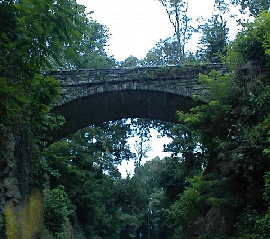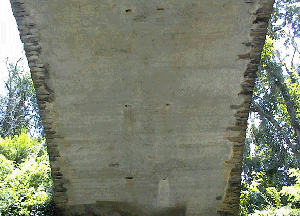 | wnc business & community directory |
|
This is an archived page that may contain outdated or incorrect information. Please visit www.Asheville.com for the latest news, events, and more.
The restoration of historic sites is passe' to many people. On some individuals, the importance of saving an historic landmark is somehow lost. The feeling, the meaning, the passion, the sense of connection found in a historic site is simply not easily registered on their minds or in their hearts. But sometimes the object being saved has a special connection beyond its architecture and construction. Sometimes an historic structure has a personal history that makes it special to a city. Such is the case with Helen's Bridge on Beaucatcher Mountain, in Asheville, North Carolina. Built in 1909 to provide access to the Zealandia Mansion on the crest of Beaucatcher Mountain, Helen's Bridge, or Zealandia's Bridge was special from its conception. The bridge was graced with beauty, both in its arched design and its quarried stone construction.  R. S. Smith was the designing Architect. R. S. Smith was the field architect for the Biltmore House and designed The Cathedral of All Souls in Biltmore Village.
Helen's Bridge was first threatened in 1976 when the North Carolina Department of Transportation decided to make the cut through Beaucatcher Mountain for Interstate-240. The bridge itself was not in the path of the construction of Interstate-240. However, the shock waves from the blasting of the granite rock in the I-240 cut posed the threat to the arched stone bridge.
Robert S. Griffin, principal architect with R. S. Griffin Architects, P.A., immediately recognized the threat of the shock waves to the bridge and successfully lobbied the North Carolina Department of Transportation to shore up the bridge with support scaffolding during the blasting period to give the bridge additional support. The support scaffolding remained in place over the next 23 years until the fall of 1999.
In 1999 there was talk of tearing down the bridge by some individuals and strong support within the preservation community to repair the bridge and reopen it. The latter group prevailed and began the initial plans for raising the funds for the repairs and the load tests.
Before the support scaffolding could be removed, load tests needed to be made to determine if the arched bridge had been damaged by the shock waves from the blasting. There were also minor repairs needed for the bulkheads; shoring up some stone work, tuck-pointing some masonry joints and replacing some missing stones were jobs that needed to be completed before the support scaffolding was removed.
The bridge itself seemed to be intact. The question remained, was the bridge structurally sound? Was it safe to remove the support scaffolding? How could this be done without risking the collapse of the bridge? Who was going to pay for this work?
Once again, Robert Griffin took the initiative. He helped to form the Zealandia Committee that raised $40,000 that helped to pay for the repairs and load test. The Asheville City Council contributed $10,000, and the Asheville City Public Works Department funded $3,685.
It was decided that the support scaffolding would be lowered two inches below the bridge. The load tests would then be made. If the bridge could not structurally support the load test, the bridge would fall only two inches. Since the bridge was going to be used for only pedestrian traffic, the test loads were limited to pedestrian limits. The bridge passed the load tests, the minor repairs were completed and the support scaffolding was removed.
R. S. Smith was the designing Architect. R. S. Smith was the field architect for the Biltmore House and designed The Cathedral of All Souls in Biltmore Village.
Helen's Bridge was first threatened in 1976 when the North Carolina Department of Transportation decided to make the cut through Beaucatcher Mountain for Interstate-240. The bridge itself was not in the path of the construction of Interstate-240. However, the shock waves from the blasting of the granite rock in the I-240 cut posed the threat to the arched stone bridge.
Robert S. Griffin, principal architect with R. S. Griffin Architects, P.A., immediately recognized the threat of the shock waves to the bridge and successfully lobbied the North Carolina Department of Transportation to shore up the bridge with support scaffolding during the blasting period to give the bridge additional support. The support scaffolding remained in place over the next 23 years until the fall of 1999.
In 1999 there was talk of tearing down the bridge by some individuals and strong support within the preservation community to repair the bridge and reopen it. The latter group prevailed and began the initial plans for raising the funds for the repairs and the load tests.
Before the support scaffolding could be removed, load tests needed to be made to determine if the arched bridge had been damaged by the shock waves from the blasting. There were also minor repairs needed for the bulkheads; shoring up some stone work, tuck-pointing some masonry joints and replacing some missing stones were jobs that needed to be completed before the support scaffolding was removed.
The bridge itself seemed to be intact. The question remained, was the bridge structurally sound? Was it safe to remove the support scaffolding? How could this be done without risking the collapse of the bridge? Who was going to pay for this work?
Once again, Robert Griffin took the initiative. He helped to form the Zealandia Committee that raised $40,000 that helped to pay for the repairs and load test. The Asheville City Council contributed $10,000, and the Asheville City Public Works Department funded $3,685.
It was decided that the support scaffolding would be lowered two inches below the bridge. The load tests would then be made. If the bridge could not structurally support the load test, the bridge would fall only two inches. Since the bridge was going to be used for only pedestrian traffic, the test loads were limited to pedestrian limits. The bridge passed the load tests, the minor repairs were completed and the support scaffolding was removed. But what gave saving Helen's Bridge its special meaning? What is the special connection to Helen's Bridge that, perhaps, can touch even those who are passe' about historic restoration?
We need only turn to Thomas Wolfe's "Look Homeward, Angel." In the book, written about Thomas Wolfe's early life in Asheville, he describes a walk he took with his girlfriend up to the crest of Beaucatcher Mountain for a picnic.
But what gave saving Helen's Bridge its special meaning? What is the special connection to Helen's Bridge that, perhaps, can touch even those who are passe' about historic restoration?
We need only turn to Thomas Wolfe's "Look Homeward, Angel." In the book, written about Thomas Wolfe's early life in Asheville, he describes a walk he took with his girlfriend up to the crest of Beaucatcher Mountain for a picnic.
all contents copyright © 1999, asheville.com. contact: [email protected] or 828.253.2880 For listing and advertising information...
|
